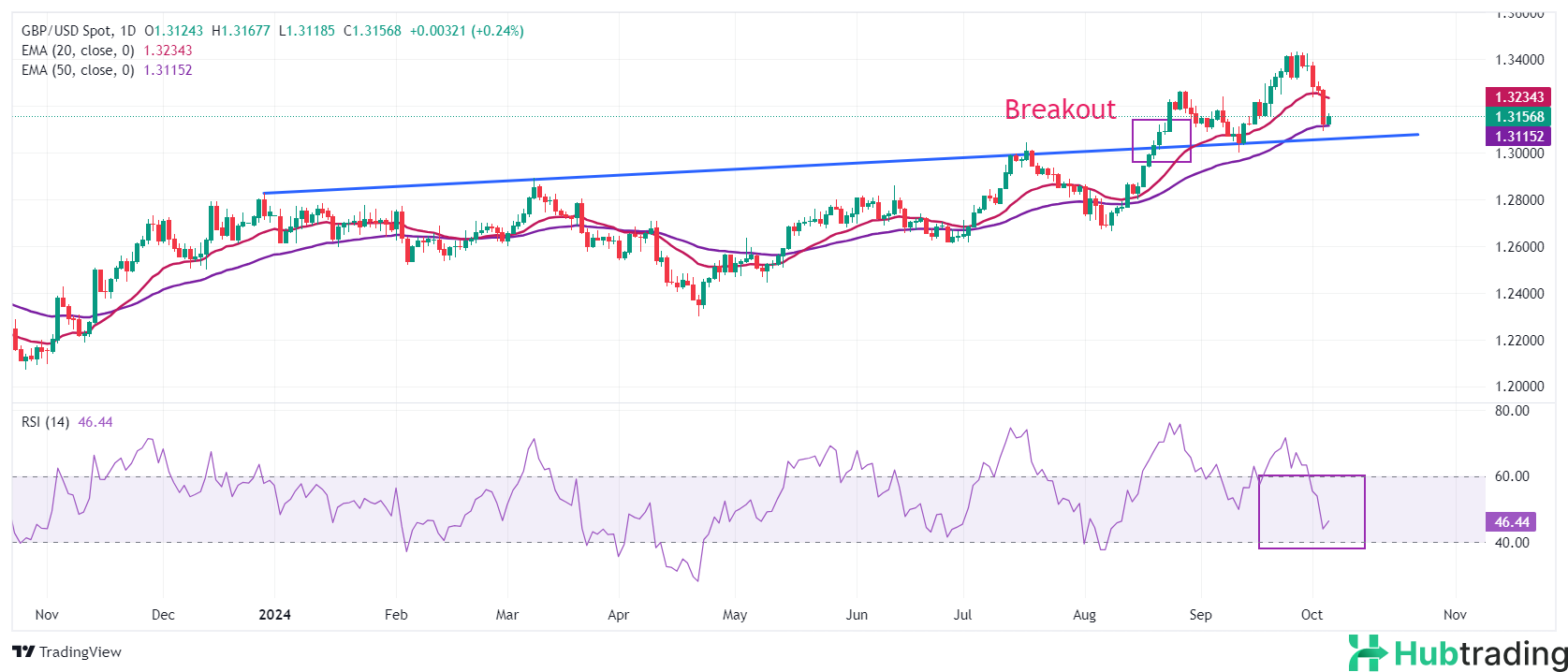- The Pound Sterling rises to approximately 1.3160 against the US Dollar ahead of the September Non-Farm Payroll report.
- The likelihood of the Federal Reserve implementing an additional 75 basis points interest rate cut by year-end has decreased considerably.
- Bank of England Governor Andrew Bailey stressed the importance of implementing aggressive interest rate cuts
The Pound Sterling (GBP) is experiencing buying interest near the significant support level of 1.3100 against the US Dollar (USD) during Friday's London session. The GBP/USD pair has climbed to 1.3160 after a three-day losing streak. However, the short-term outlook remains uncertain as investors await the release of the US Nonfarm Payrolls (NFP) report for September at 12:30 GMT.
Market participants are keenly focused on the US NFP data, which will provide insights into the current health of the US labor market. The US Federal Reserve (Fed) recently initiated a policy-easing cycle with a notable 50 basis points (bps) interest rate cut in September, aimed at revitalizing labor market strength amidst declining price pressures.
The official employment report is anticipated to show that US employers hired 140,000 job-seekers, slightly down from August’s figure of 142,000. The unemployment rate is expected to remain steady at 4.2%.
Investors will also monitor the Average Hourly Earnings data, a crucial indicator of wage inflation impacting consumer spending. This is expected to grow steadily by 3.8% year-over-year, with monthly wage growth projected at 0.3%, slower than August's 0.4%.
This labor market data will significantly influence the Fed's monetary policy decisions for the remaining meetings this year. According to the CME FedWatch tool, the likelihood of a further 75 basis point interest rate cut by the Fed by year-end has decreased to 55%, down from 79% a week ago.
Daily Digest Market Movers: Pound Sterling Outperforms Major Peers
- On Friday, the Pound Sterling outperforms its major peers. However, it may face pressure due to escalating tensions between Iran and Israel, which have escalated into full-scale conflict following the assassination of Hezbollah leader Hassan Nasrallah. This has led to a rally in oil prices amid Middle Eastern tensions. Historically, a sharp rise in energy prices negatively impacts currencies of economies heavily reliant on imported oil due to increased foreign outflows.
- Additionally, comments from BoE Governor Andrew Bailey regarding the interest rate outlook have dampened Sterling’s prospects. In an interview with the Guardian, Bailey suggested a dovish stance, emphasizing the need for aggressive interest rate cuts if price pressures continue to ease.
- He indicated that the Bank of England (BoE) could adopt a "more activist" and "more aggressive" approach to rate reductions if inflation trends positively for the central bank, according to Reuters.
- On the economic front, the revised S&P Global/CIPS Construction PMI estimate unexpectedly rose to 57.2, significantly higher than expectations, which had anticipated a slower pace of expansion to 53.1 from preliminary estimates of 53.6.
Technical Analysis: Pound Sterling Finds Support Near 50-Day EMA

The Pound Sterling is currently finding temporary support near the 50-day Exponential Moving Average (EMA), which stands at approximately 1.3115 against the US Dollar. The GBP/USD has recovered after a sharp correction to around 1.3090 on Thursday, following a peak of 1.3430 recorded on September 26.
The 14-day Relative Strength Index (RSI) is declining within the 40.00-60.00 range, indicating a weakening momentum. Further downside risks could push the pair toward the trendline near 1.3060, derived from the December 28, 2023, high of 1.2828. The pair previously saw a strong upside move following a breakout of this line on August 21. On the upside, the 20-day EMA near 1.3234 will act as a significant barrier for Pound Sterling bulls.





